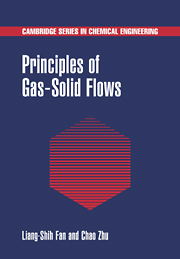Book contents
- Frontmatter
- Contents
- Preface
- Part I Basic Relationships
- Part II System Characteristics
- 7 Gas–Solid Separation
- 8 Hopper and Standpipe Flows
- 9 Dense-Phase Fluidized Beds
- 10 Circulating Fluidized Beds
- 11 Pneumatic Conveying of Solids
- 12 Heat and Mass Transfer Phenomena in Fluidization Systems
- Appendix: Summary of Scalar, Vector, and Tensor Notation
- Index
7 - Gas–Solid Separation
from Part II - System Characteristics
Published online by Cambridge University Press: 27 October 2009
- Frontmatter
- Contents
- Preface
- Part I Basic Relationships
- Part II System Characteristics
- 7 Gas–Solid Separation
- 8 Hopper and Standpipe Flows
- 9 Dense-Phase Fluidized Beds
- 10 Circulating Fluidized Beds
- 11 Pneumatic Conveying of Solids
- 12 Heat and Mass Transfer Phenomena in Fluidization Systems
- Appendix: Summary of Scalar, Vector, and Tensor Notation
- Index
Summary
Introduction
Separation processes are central to gas–solid flow systems concerning dust removal, particulate collection, sampling, particle recirculation, and other operations. Gas–solid separation can be achieved by application of the principles involving centrifugation, electrostatic effects, filtration, gravitational settling, and wet scrubbing. Gas–solid separators applying these principles employ rotary flow dust separators, electrostatic precipitators, filters, settling chambers, and scrubbers. In order to yield highly efficient solids collection or removal processes, multistage gas–solid separators based on a combination of several of these components are also commonly employed.
In this chapter, the collection mechanisms, types, and collection efficiencies of gas–solid separators are discussed. Specifically, separation by rotating flow, exemplified by a cyclone separator, is presented. Tangential flow cyclones, which are the most commonly used cyclones, are described. The principles of electrostatic precipitation are illustrated. Comments are presented with respect to the difficulties involved in obtaining an accurate estimation of the collection efficiency of an electrostatic precipitator. Factors contributing to these difficulties include the geometric complexity of the system, significant flow disturbance due to electric wind, and poor predictability of particle charges. Concepts on filtration are also introduced. A filtration process can collect particles of almost all sizes; however, the pressure drop across the filter may vary significantly with the internal structure of the filter, particle deposition mode (cake or in-depth deposition), and quantity of accumulated particles. Wet scrubbing, which produces wet sludge from the impaction of solids with liquid droplets, is also delineated in this chapter.
- Type
- Chapter
- Information
- Principles of Gas-Solid Flows , pp. 297 - 332Publisher: Cambridge University PressPrint publication year: 1998



